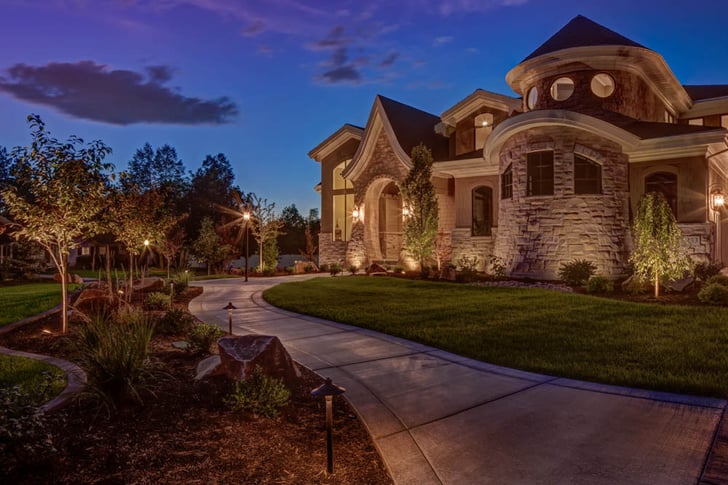The best control/timer for your outdoor landscape lighting system
With different smart home automation control systems, automating your outdoor lighting is becoming as simple as plugging your transformer into the wall and letting your smart home know, via app, when you’d like your lights turned on & off.
While this futuristic technology is truly spectacular, most of us do not have smart home automation.
But this doesn’t mean that we have to live in the stone age either!
With a variety of different transformer control systems available, there is bound to be a control system suited to your specific needs & budget.
What is the best control for your outdoor lighting system?
Well, that really depends on what your needs are.
There are two types of transformers:
- Ones with an integrated control that can’t be switched out.
- Ones with space available inside for plug-and-play.
Some control systems are fairly basic, others can be a bit more sophisticated.
As we take a look at some of these control systems, we will do our best to hit on some of the pros and cons of each.
1. Analog timer
An analog timer is simply a mechanical timer.
You know the old school timers used to turn lamps on and off at night in your home to make it look like somebody is there.
These timers are pretty straightforward.
While these timers can be set relatively easily, there are a few downsides to them.
PROS:
1. It’s affordable
2. Can be set easily.
CONS:
1. This timer will need to be reset whenever there is a power outage.
2. Mechanical failures can occur over time.
3. Will not adjust for sunset
4. Will not adjust for daylight savings.

2. Digital timer
A digital timer is a big step up from an analog timer.
While they can be a bit more difficult to program, the instructions are usually pretty straightforward.
With most digital timers, you can set multiple on/off programs for different days of the week.
With a digital timer, you are given a lot more control over when your lights come on and off.
A good digital timer will have an internal battery in case of a power outage. If the power were to go out, your timer will save its programming and continue operating once the power has been restored.
PROS:
1. Affordability
2. Ability to set various on/off programs.
3. Built-in battery with internal memory in case of power outage.
4. May adjust automatically for Daylight Savings.
CONS:
1. Batteries need to be replaced every couple of years.
2. Some models do not adjust for Daylight Savings
3. Does not adjust for sunset.
3. Photocell
A photocell is a light sensor.
It senses sunlight to determine when the lights should turn on and off.
While photocells come in various shapes and sizes, they operate the same way.
A photocell is a great way to ensure that your lights will turn on at sunset.
However, a downside to a photocell is that it will not shut off until it senses light again at sunrise.
PROS:
1. Affordability
2. Will ensure that your lights adjust for sunset and sunrise throughout the year.
3. Great if you want your lights to always come on between sunrise & sunset.
4. Very dependable.
CONS:
1. Can not be used effectively on transformers located in dark or heavily shaded areas.
2. Will not shut off at designated time.

4. Control combination
A photocell is great for ensuring that your lights will adjust for sunset throughout the year, and turn on whenever it’s dark.
The biggest issue with them is that they won’t shut off at a specific or designated time.
One way to get the best of both worlds (adjustment and control) is by combining the two. Using a photocell in combination with a timer will enable you to have your lights turn on at sunset, and turn off when you want them to.
By using a photocell with your timer you give yourself more control over how the system operates. The photocell turns the lights on, the timer turns them off.
PROS:
1. Affordability
2. Your lights will turn on at sunset and shut off at whatever designated time you’d like.
3. You can trust your lighting system to operate more smoothly.
CONS:
1. Whether you choose an astronomical or digital timer, they will still need to be reset for Daylight Savings.
2. Will not be effective if the transformer is located in a dark or heavily shaded area, or if it is located in a well-lit location.
5. Astronomical timer
An astronomical timer is a much more sophisticated control system than the previously mentioned control system.
While the programming may feel somewhat more involved, astronomical timers are extremely effective.
Unlike photocell timers, astronomical timers don’t need to sense the light outside to determine what time the sun is setting. With an astronomical timer, your transformer’s location becomes irrelevant.
Like a digital timer, an astronomical can be set to various on/off times for different days. You can have your lights shut off at midnight on weekdays and 2:00 A.M. on weekends. An astronomical timer also has a memory with a built-in battery.
Unlike a digital timer, an astronomical timer can be set to adjust itself for daylight savings, it’s extremely accurate & shouldn’t require any adjusting after the initial setup.
PROS:
1. Affordability
2. It can adjust itself for sunset and daylight savings without many of the shortcomings we find with digital timers and photocells.
3. Backup for memory in case of power outage.
CONS:
1. Astronomical timers are typically a little bit more robust than other control devices. Some transformers may not be accommodating to the amount of space it requires to be housed inside of the transformer. If you are planning out your system ahead of time this isn’t really an issue. However, if you are retrofitting your old system, it’s good to double-check and make sure an astronomical timer will fit in your transformer.
2. The programming can be a little bit more involved than other control devices.
3. Backup batteries need to be replaced every 2 years.

6. WiFi/Bluetooth smart control
There are numerous different products that offer you the ability to outfit your lighting system with a control-operated smart device.
There are several different products out there that offer a variety of different features.
Rather than get into the specifics of each, what we’ll do is briefly skim over some of the neat features of this type of control system.:
1. On/off can be set
2. You can manually turn your lights on and off with your phone.
3. With certain systems, this can even be done when you are away from home.
4. Certain systems give you the ability to dim your lighting and control different zones.
5. Advanced systems give you the ability to control the color of your lights.
PROS:
1. If you are looking to have full control over numerous aspects of your lighting system, smart control is a good fit for you.
CONS:
1. This is not as affordable as some of the other timers we previously mentioned.
2. These systems are pretty incredible in terms of the control they provide but just keep in mind that they often come with an incredible price tag. Smart design & strategic planning can certainly save time & experience when considering these options.
Do you know what type of landscape lighting timer you would like?
If you enjoy having a lot of control over your lighting system, a smart-controlled device may be a great fit for you. But at the end of the day, if you just want your lights to turn on and off when they are supposed to, there are a great number of options available to you.
Give us a call at (801) 440-7647 to learn more about our timers or fill out a contact form to learn more!
Salt Lake City (Midvale)
801-440-7647
St. George
435-932-6627
©2025 Landscape Lighting Pro
Privacy Policy
Cookie Policy